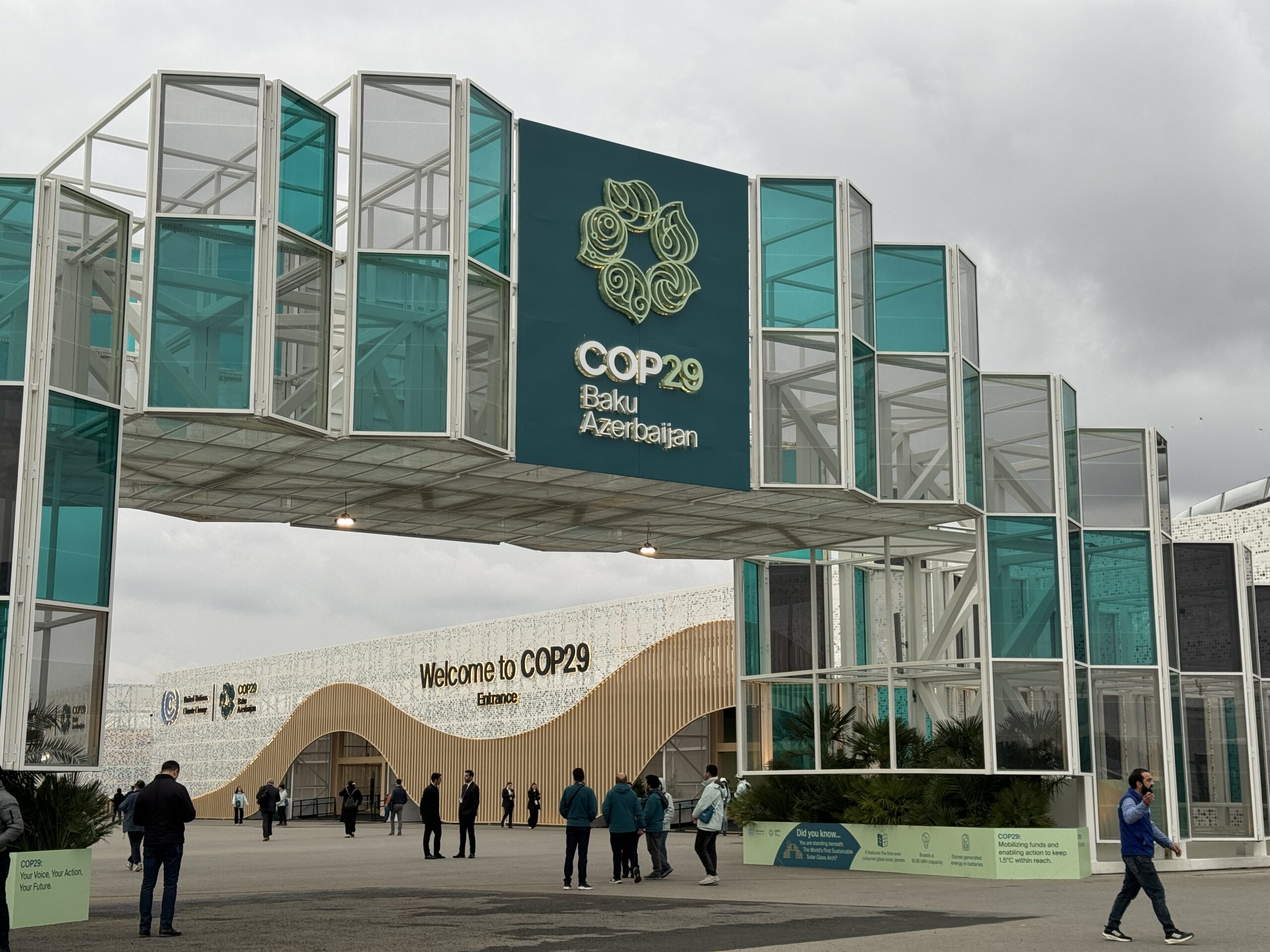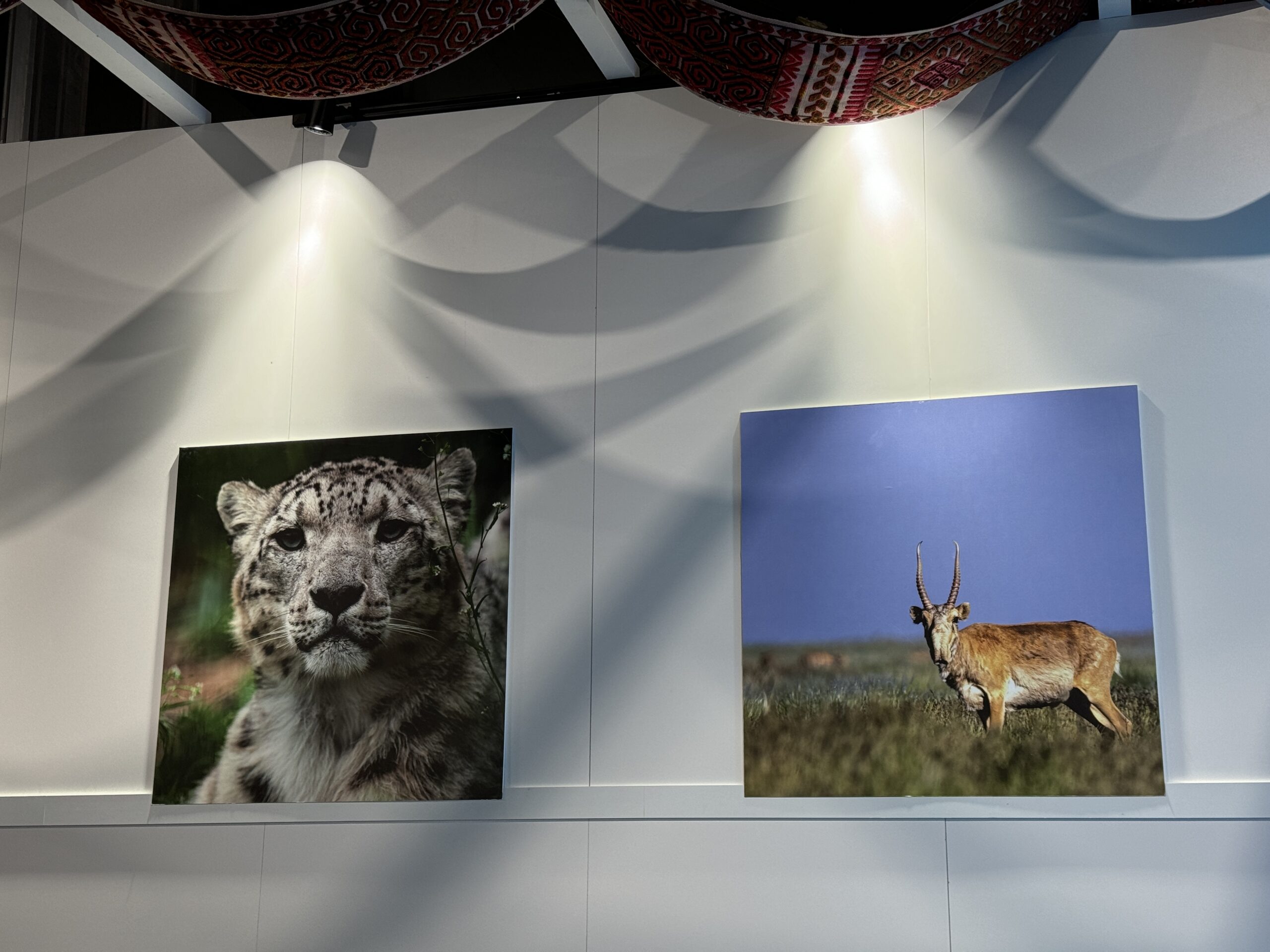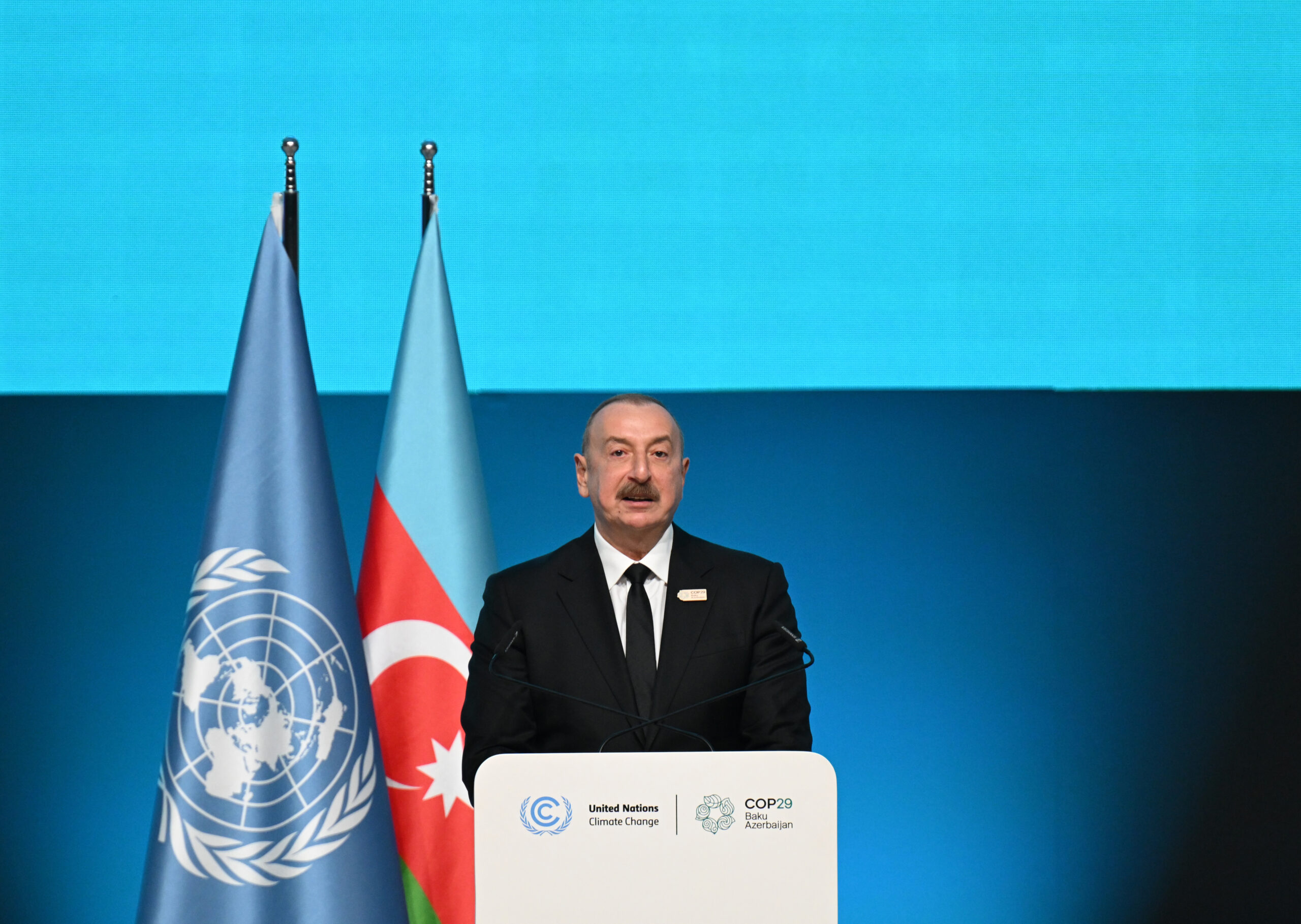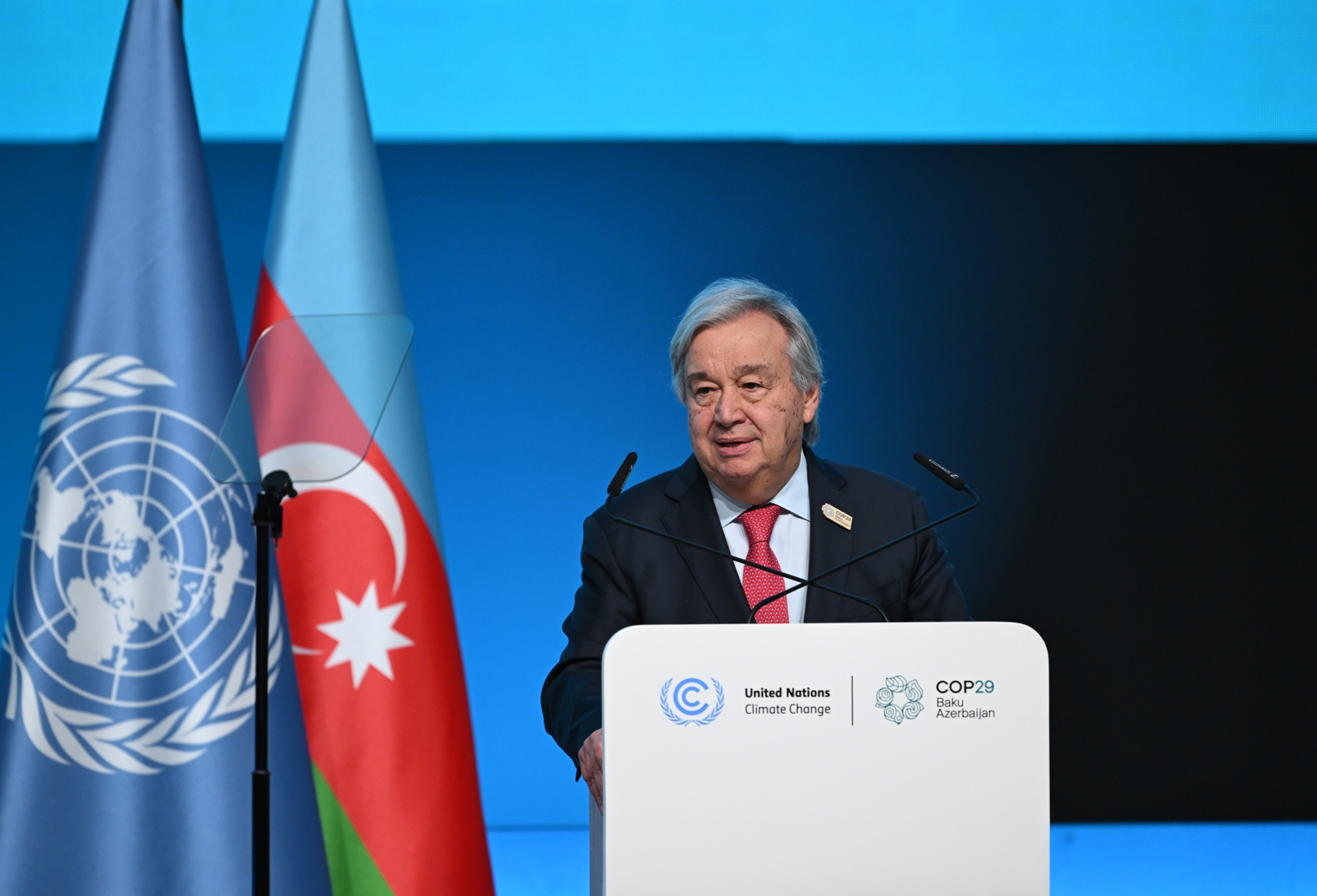BAKU – Kazakhstan presents the national pavilion at the 29th United Nations Climate Conference of the Parties (COP29), which kicked off on Nov. 11 at the Olympic Stadium in Baku and will run through Nov. 22.

COP29 kicked off on Nov. 11, gathering more than 70,000 delegates from nearly 200 countries. Photo credit: Assel Satubaldina/The Astana Times
Kazakhstan’s pavilion, a centerpiece of the country’s presence at the UN Climate Conference, highlights what the nation is doing at home and around the world to tackle climate change, as it pledged to achieve carbon neutrality by 2060.
The 150-square-meter pavilion, crafted in an ethno-minimalist style, merges modern design with Kazakh traditions. It draws from natural materials such as wood, stone, and textiles, reflecting Kazakhstan’s eco-conscious approach.

The national pavilion is located at he UN Climate Change Pavilion, a space designed to showcasing key climate actions, initiatives and partnerships. Photo credit: Assel Satubaldina/ The Astana Times
Visitors are guided through several distinct areas, each showcasing aspects of Kazakhstan’s climate strategies and cultural legacy. But before that, they are invited to a tasting area with samples of traditional Kazakh dishes, including the iconic Aport apples.
Key exhibits include a model of Kazakhstan’s green hydrogen production project and sculptures of saiga antelopes by artist Gulfiya Meldesh. A unique interactive wall offers an augmented reality experience, where visitors can scan QR codes to witness “living” depictions of Kazakhstan’s biodiversity, including Przewalski’s horses, saiga antelopes, and snow leopards.

Sculptures of saiga antelopes, one of the species which Kazakhstan has been trying to protect over the years. Photo credit: Assel Satubaldina/ The Astana Times
Didar Karimsakov, director of the International Green Technologies and Investments Center, said the pavilion will host nearly 30 thematic sessions. One of the side events hosted by the IGTIC will focus on the Bureau of the Best Available Techniques (BAT), which the center runs.
“We would like to expand it throughout Central Asia. Similar centers are working in the European Union. BATs are being used in EU and OECD countries. We have developed 16 reference documents, which will become mandatory for the top 50 polluters starting Jan. 1, 2025. This will help us reduce emissions by almost twofold,” he told The Astana Times.
Karimsakov stressed Kazakhstan’s vast potential in renewables, specifically wind and solar.
“Several agreements were signed just today, including one regarding water resources. We suppose these projects will help reduce climate risks and achieve carbon neutrality,” he added.
Karimsakov hopes the national pavilion will drive new partnerships and investments. “We are open to cooperation,” he added.

An interactive wall with some of the species, which Kazakhstan has been protecting and preserving over the years. Photo credit: Assel Satubaldina/The Astana Times
Kazakhstan at COP29
Speaking to The Astana Times, Minister of Ecology and Natural Resources Yerlan Nyssanbayev said the nation is in Baku to present several initiatives.
“The first initiative is on carbon farming. Given various circumstances and the impact of global warming, we all understand that agriculture requires significant investment, particularly in restoring degraded lands. This issue is worsening year by year due to climate change. It is important to realize that these lands must contribute to reducing the greenhouse effect by absorbing carbon,” said the minister.

The Astana Times journalist Assel Satubaldina and Minister Nyssanbayev. Photo credit: Assel Satubaldina/The Astana Times
He stressed the need for increased funding for green projects, specifically in the agricultural sector.
“The second focus is on developing a carbon trading platform. We are talking about an emissions trading system. Kazakhstan was one of the first countries to implement a cap-and-trade system, but there is a need to study international experience and revitalize our domestic market,” said Nyssanbayev.
“We propose paying greater attention to carbon trading systems, not just from a local perspective but by working to systematize efforts on a regional and even global scale. Many countries address these issues by adopting local legislative frameworks and implementing their own trading systems. Solving these challenges effectively at a regional or global level requires coordinated efforts,” he said.
Speaking of cooperation with Central Asian neighbors, the minister said it is strong, but the pressing challenge now is funding.
“Working together with neighboring partner countries is essential. We need to prioritize regional projects and solutions. For example, our third initiative is the development of BAT Center. This proposal has already received support from several Central Asian countries, including responses from Kyrgyzstan and Uzbekistan,” he said.
What is COP29?
COP29 gathers more than 70,000 delegates from 196 countries. Around 80 world leaders participate in the conference, where the top priority is to negotiate a new climate finance goal.

World leaders pose for a group photo before the World Leaders Climate Action Summit on Nov. 12. Photo credit: COP29 press office
The COP29 opening on Nov. 11 featured the official handing over of the COP Presidency from the United Arab Emirates to Azerbaijan. COP28 President Sultan Al Jaber urged the participants to “prove once again that we can unite, act, and deliver” over the next two weeks in Baku, referencing the key slogan of the COP29.
“When sectors work together, we can lift economies and lower emissions. We can make climate and socio-economic progress together at the same time and we can turn declarations on paper into decisive action on the ground,” he said.
In his opening address, COP29 President and Azerbaijan’s Minister of Ecology and Natural Resources Mukhtar Babayev discussed how current policies lead the world to “catastrophic” warming of three degrees Celsius, citing the latest UN Environment Program Emissions Gap Report.
“We are on a road to ruin. These are not the future problems. Climate change is already here,” he said. “Whether you see them or not, people are suffering in the shadows. They are dying in the dark. And they need more than compassion, more than prayers and paperwork. They are crying out for leadership and action. COP29 is the unmissable moment that can chart a new path forward for everyone.”
Azerbaijan’s presidency focuses on two pillars – enhancing ambition and enabling action.
“This means setting out clear climate plans and delivering the finance we need. These two pillars are mutually reinforcing,” he added.
To drive progress, Babayev highlighted reaching a fair and ambitious New Collective Quantified Goal on climate finance as the main priority for COP29 negotiations. He acknowledged progress in areas such as structure, access mechanisms, transparency, and timelines while pointing out ongoing disagreements about contributors and the scale of the final goal.
Key progress
On Nov. 11, COP29 concluded the first day with progress on one of the key priorities, as the parties to the UNFCC agreed on the standards for the creation of carbon credits under Article 6.4 of the Paris Agreement. This part of the Paris Agreement allows for trading carbon credits between countries and companies around the world, making it easier and cheaper to reduce emissions.

President of Azerbaijan Ilham Aliyev delivers remarks at the opening of the World Leaders Climate Action Summit on Nov. 12. Photo credit: COP29 press office
“This is a critical step towards concluding Article 6 negotiations. This will be a game-changing tool to direct resources to the developing world and help us save up to $250 billion a year when implementing our climate plans,” said Yalchin Rafiyev, lead negotiator at COP29.
UN vision
Addressing the World Leaders Climate Action summit on Nov. 12, UN Secretary-General Antonio Guterres stressed that to limit global temperature rise to 1.5 degrees Celsius, the world must cut global emissions by 9% yearly. By 2030, they must fall 43% on 2019 levels.

Antonio Guterres addresses the summit on Nov. 12. Photo credit: COP29 press office
“Humanity is behind you: a poll by the University of Oxford and the United Nations Development Programme finds that 80% of people around the world want more climate action. Scientists, activists, and young people are demanding change – they must be heard, not silenced,” he said.
He called on the countries to focus on three priorities – emergency emissions reductions, protecting people from what he described as the “ravages of the climate crisis,” and finance.
Addressing the summit, Simon Stiell, executive secretary of UN Climate Change, noted climate change is “fast becoming an economy-killer.”
“We used to talk about climate action as being mostly about saving future generations. But there has been a seismic shift in the global climate crisis. Because the climate crisis is fast becoming an economy-killer. Right now, today, in this political cycle. Climate impacts are carving up to 5% off GDP in many countries,” he said.
Stiell is sure that investing in climate action will drive economic opportunities.
“It means more jobs, more growth, less pollution choking cities, healthier citizens and stronger businesses. Billions of people simply cannot afford for their governments to leave COP29 without a global climate finance goal,” he said.


